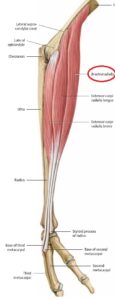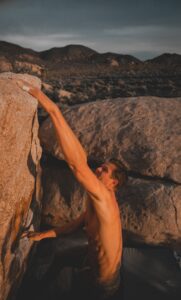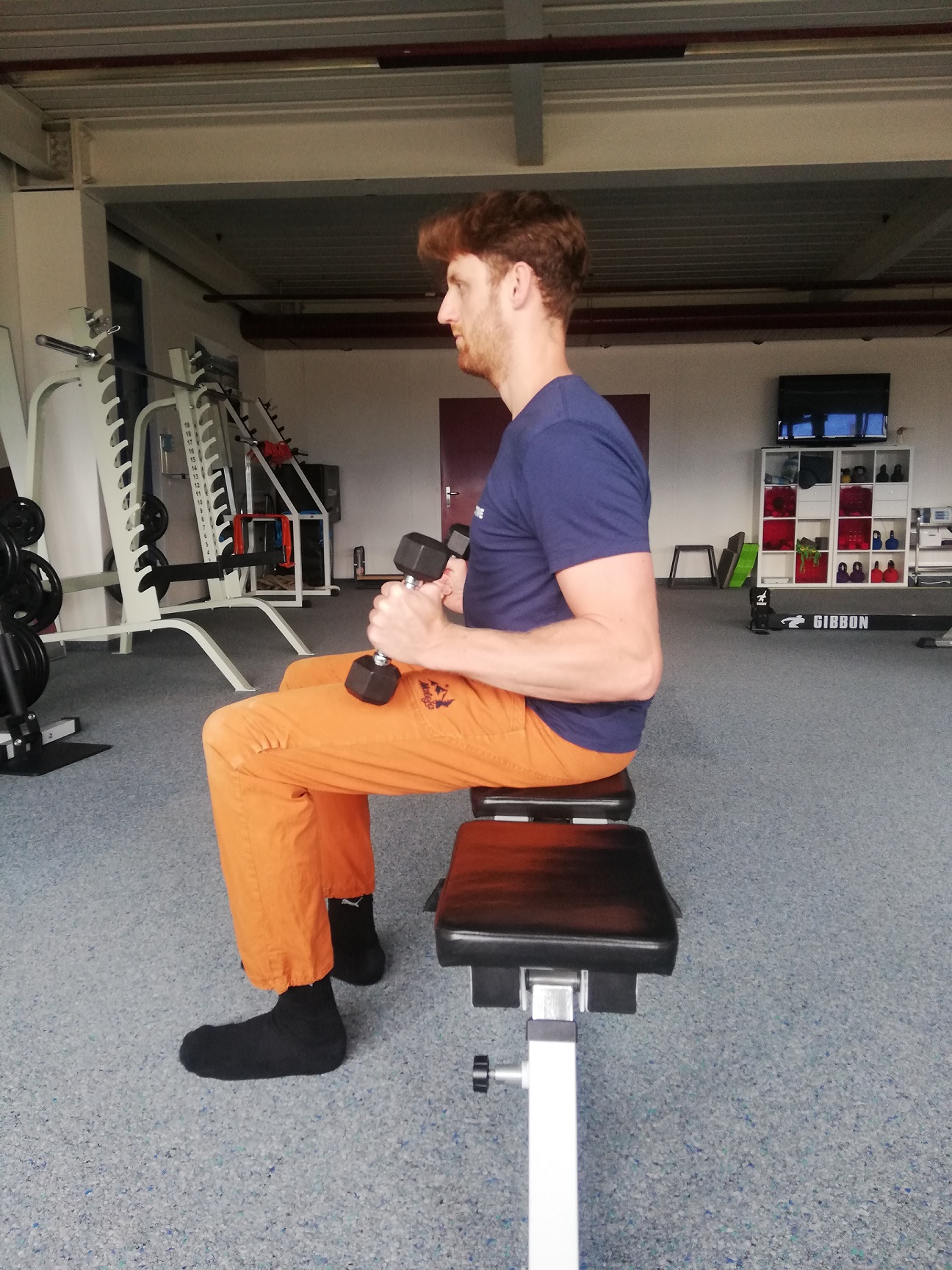The best way to heal brachioradialis tendinopathy is by reducing your climbing intensity or by stopping rock climbing for several weeks. In the meantime, start strengthening and stretching your brachioradialis increasing the intensity over 12 weeks. When you’re pain-free in rest and you can climb with a pain intensity of 3/10 or less, you can return to rock climbing, increasing the intensity and frequency for 6 weeks.
The entire rehab process requires dedication and discipline, mostly by refraining (partially) from rock climbing or bouldering. Nevertheless, I believe that with the right information, you will heal your injury.
That’s why in this blog I explain how you can heal your brachioradialis tendinopathy according to a 3-step plan. During each step, I explain what you should train and whether you can keep climbing or not.
Yes, it might take a while to become pain-free. But in the long term, the time you spend on rehabbing your elbow will be nothing compared to the amount of time you can climb after.
Good luck!
1. What is the Function of the Brachioradialis Muscle (In Climbing?)
The function of the brachioradialis muscle is to flex your elbow, wrist extension, and abduction. This means that for climbers this muscle is not essential to generate finger force. It is however an important assisting muscle because you have to flex your elbow during every climbing movement.
Moreover, the abduction movement being little as it is, has its importance when climbing on slopy surfaces. As things go, there’s less opportunity for your finger flexors to generate force. Which increases the importance of other working muscles.

2. What is Brachioradialis Tendinopathy?
Tendinopathy of the brachioradialis is a situation where your tendon is losing strength due to overuse. As a result, you might experience pain, weakness, and inflammation.
But how come your tendon does lose strength?
To answer that question, we have to dive deep into your tendons. More specifically, small cells in your tendons, called tenocytes.
Tenocytes are responsible for the construction and breakdown of tendonous tissue. They respond to the way you load your tendon. Do you load your tendon often by climbing frequently, doing physical labor, or clicking the mouse frequently? Then, tenocytes in this tendon will produce more tendenous tissue. And, in the opposite case, the opposite happens. Inactivity, like a prolonged break from climbing, will reduce the production of tendonous tissue and the strength of the tendons of your fingers and forearm. This is one of the reasons that you need to start slowly when increasing your climbing intensity after a break. Even if you’re an experienced climber.
Now, that’s what happens in a healthy tendon.
When your tendon is affected by tendinopathy, this process is broken. Due to overload, your tenocytes aren’t constructing tendon tissue anymore. On the contrary, they’re now breaking down the tendon issue (why it happens this way is unknown). This then leads to a loss of strength, pain, and sometimes inflammation. Why does this happen exactly? That remains to be discovered.
The trick is, therefore, to bring the load on your tendon back into balance so that your tenocytes have time to recover and restart constructing more tendons instead of breaking it down. More on that in a bit.
3. Why Did You Develop Brachioradialis Tendinopathy?
You have developed brachioradialis tendinopathy due to overuse. This can be a result of a large increase in your climbing intensity, climbing frequency, and climbing surface. In particular, climbing on a lot of slopers demands a lot of elbow strength and also forces you to abduct your hand more frequently.
The hand abduction I find particularly interesting because it’s such a small movement. Still, hand abduction and elbow flexion are synergetic movements (movements working in the same direction of force) and are both generated by the same muscle: the brachioradialis.
And one more time, because you can’t rely as much on finger strength on slopers you generate more force out of your elbow flexors and wrist flexors and abductors.

4. 3-Step Plan for Healing Brachioradialis Tendinopathy
The 3-step plan to heal brachioradialis tendinopathy is a template that you can use regardless of the severity of your injury. If you’re experiencing pain for less than a month you can follow this template while reducing your climbing frequency by 50% and by climbing 1-2 grades below your onsight level. Besides that, it’s smart to evade slopers.
Are you experiencing pain for longer than a month?
Then it’s a good idea to take at least a break of 2 weeks from climbing. When you’re experiencing pain for over 3 months then I recommend you take a break of 4 weeks from climbing.
Each of the 3 steps towards healing your tendinopathy takes 4 weeks. Here’s a quick overview of each of the steps:
- 4 weeks of daily isometric exercises (strength training for the brachioradialis without movement) combined with stretching daily
- 4 weeks of daily eccentric exercises (strength training for the brachioradialis with an emphasis on the lengthening part of the movement) combined with stretching daily
- 4 weeks of daily concentric exercises (normal strength training for the brachioradialis) combined with stretching every other day
4.1 Step 1: Isometrics
Do the following exercises daily:
- 3x6x10seconds Isometric Elbow Flexion with wrist abduction on both sides
- 3x30seconds stretching of the brachioradialis, alternating between sides.

If you have no pain outside of climbing and your injury isn’t older than 4 weeks you can keep climbing at a lower intensity. However, are you experiencing pain at rest, have signs of inflammation, and/or are you experiencing symptoms longer than 4 weeks? Then take a break from climbing for at least 2 weeks.
In the meantime, you do the aforementioned exercises. You’re allowed to feel pain with an intensity of 4-5/10 during the exercises. Once you stop, the pain should fade away.
You can increase the weight if you can do the exercise in a controlled fashion within the pain limits.
4.2 Step 2: Eccentrics
Do the following exercises daily:
- 3x6x10seconds Eccentric Elbow Flexion with wrist abduction alternating between sides.
- 3x30seconds stretching of the brachioradialis, alternating between sides.
If you kept climbing during step 1 you can now increase your climbing intensity, however not the frequency! Make sure you never climb 2 days in a row.
Didn’t you climb at all during step 1?
You can start climbing again if:
- All inflammatory symptoms are gone
- You have 0/10 pain during your daily life
Start climbing at least 2 grades below you on sight level and never climb 2 days in a row.
4.3 Step 3: Concentrics
Do the following exercises daily:
- 3×15 weighted Elbow Flexion with wrist abduction on both sides
- 3x30seconds stretching of the brachioradialis, alternating between sides, every other day.
- Start sub-maximal hang board training
The development of your climbing intensity in this phase depends on the severity of your symptoms. Are you still experiencing pain while climbing? Then don’t change anything. Keep doing your exercises and keep climbing at the same frequency and intensity.
Are you entirely pain-free while climbing? Then you can start to slowly increase your climbing intensity.
The smartest way to do that?
That, you read below.
5. Returning to Climbing (or how to Keep Climbing when Suffering from a Brachioradialis Tendinopathy)
How and when you can return to climbing after recovery from brachioradialis tendinopathy depends on the severity of your injury, on how long your injury existed before you started treatment, and on your climbing intensity and frequency at the time of injury. Besides, remember that manual labor, including using a computer mouse, and manual hobbies like playing the piano also influence your healingproces.
In the previous chapters, I already mentioned a few times when you can or cannot keep climbing. Now, I’ll explain how to return to climbing after you completed the 3-step rehab plan.
Before you start climbing again though, you should be entirely pain-free in your daily life.
So, are you pain-free?
Then you’re ready to grab some plastic again. Yes, preferably plastic, not rock, because you can choose the holds you climb on better. If you’re the exception that knows a local crag inside out, you can go there as well.
Over 6 weeks, you’re going to return to your pre-injury climbing level. I divided these 6 weeks into 4 steps. I’ll explain how to increase your climbing intensity step by step
5.1 Step 1: Week 1-2
- Build up from climbing 3 grades below sight grade to 1 grade below your sight grade.
- Climb slabs or straight walls
- Climb 6 routes max
- Climb maximum 3 times per week but never 2 days in a row
- Stretch your forearm muscles after climbing regardless wether you feel pain or not
5.2 Step 2: Week 3-4
- Climb at on sight level
- Climb straight to slightly overhanging walls
- Climb 8 routes max
- Climb at most 4 times a week but never 2 days in a row
- Stretch your forearm muscles after climbing regardless wether you feel pain or not
5.3 Step 3: Week 5-6
- Climb at on sight level
- Climb all types of walls
- Climb 10 routes max
- Climb at most 4 times a week but never 2 days in a row
- Stretch your forearm muscles after climbing regardless wether you feel pain or not
5.4 Step 4: Week 6+
- Climb everything
- Start projecting again
- If you notice tension in your forearms, stretch (all) your forearm muscles
- If relevant, start campus training
- If relevant, (re)start hang board training
6. Important Take-Aways
In this blog, I discussed how rock climbers can to heal from brachioradialis tendinopathy. If you followed the 3-step template I’m sure you took control of your elbow pain. Remember though, it’s better to be safe than sorry. So, if you’re not sure, climb less and rest more while continuing the exercises I prescribed.
Are you still not sure whether you can keep climbing or not while you are treating your elbow pain?
Send me an e-mail at [email protected] .
